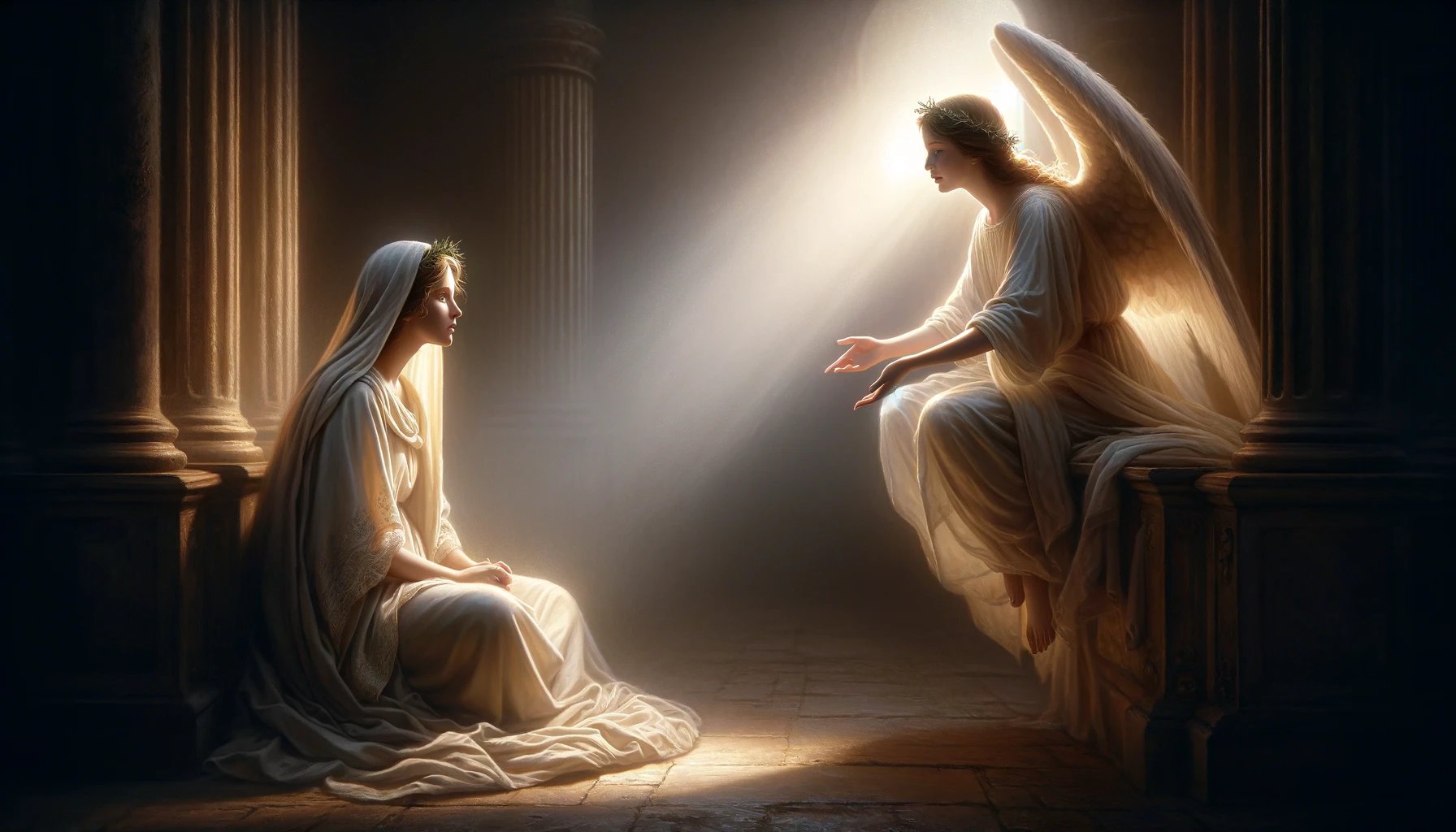Home>Special Themes>When Does Advent Starts


Special Themes
When Does Advent Starts
Published: February 14, 2024
Jason DeRose, Managing Editor at Christian.net, uses his expertise in religion and journalism to deepen understanding of faith's societal impacts. His editorial leadership, coupled with a strong academic background, enriches the platform’s diverse content, earning him recognition in both journalism and religious circles.
Discover the significance of Advent and its special themes. Learn when Advent starts and how it is celebrated in this insightful guide.
(Many of the links in this article redirect to a specific reviewed product. Your purchase of these products through affiliate links helps to generate commission for Christian.net, at no extra cost. Learn more)
Table of Contents
Introduction
Advent is a time of anticipation, preparation, and hope. It marks the beginning of the liturgical year in many Christian traditions and is a period of spiritual significance leading up to Christmas. The word "Advent" is derived from the Latin word "adventus," meaning "coming" or "arrival," and it symbolizes the coming of Jesus Christ into the world.
During Advent, believers reflect on the prophecies of the Messiah's coming and prepare their hearts to celebrate the birth of Jesus. It is a time of joyful expectation and spiritual contemplation, as well as a season of repentance and renewal. The traditions and customs associated with Advent vary across different denominations and cultures, but the central theme remains consistent – the anticipation of the arrival of the Savior.
As the days grow shorter and the nights longer, the lighting of Advent candles serves as a symbolic reminder of the increasing anticipation and hope for the coming of Christ. Each candle represents different aspects of the Advent journey, such as hope, peace, joy, and love. The lighting of these candles during the Advent season is a visual representation of the spiritual enlightenment and the gradual approach of the celebration of Christ's birth.
The observance of Advent provides a time for believers to pause amidst the hustle and bustle of the holiday season, to reflect on the deeper meaning of Christmas, and to prepare their hearts to welcome the Christ child. It is a time of spiritual introspection and a call to embrace the virtues of faith, hope, and love.
Throughout history, Advent has been a cherished and sacred season for Christians around the world. It serves as a reminder of the profound significance of the incarnation of Jesus Christ and the promise of salvation. As we delve into the history, traditions, and meaning of Advent, we embark on a journey of spiritual enrichment and renewal, preparing our hearts to welcome the light of Christ into our lives.
Read more: When Does Coptic Lent Start
The History of Advent
The history of Advent dates back to the early centuries of Christianity, with its origins rooted in the practices of the Western Church. The precise beginnings of Advent as a liturgical season are not definitively documented, but its emergence can be traced to the early medieval period. The development of Advent as a period of preparation for the celebration of Christmas evolved gradually over time, influenced by various religious and cultural factors.
In the early Christian era, the focus of Advent was primarily on penitence and fasting, akin to the observance of Lent. The duration of Advent varied, with some regions observing a period of five weeks, while others practiced a shorter period of fasting leading up to Christmas. The emphasis on spiritual preparation and repentance during Advent reflected the anticipation of the coming of Christ and the need for inner purification in readiness for the celebration of His birth.
The liturgical structure of Advent as a distinct season within the church calendar began to take shape in the 6th century. The Council of Tours in 567 AD is often cited as an important milestone in the formal establishment of Advent as a period of preparation for the Nativity. During this time, the observance of Advent became more standardized, with an increased focus on the themes of hope, expectation, and spiritual readiness.
The symbolic significance of Advent was further enriched by the introduction of Advent wreaths and candles in the Middle Ages. The circular shape of the wreath, representing eternity and the unending love of God, became intertwined with the Advent observance. The lighting of candles, initially used as a practical means of marking the passage of time during the dark winter evenings, gradually acquired spiritual symbolism, with each candle representing a different aspect of the Advent journey.
The evolution of Advent as a season of joyful anticipation and spiritual reflection continued through the centuries, influenced by the liturgical reforms and theological developments within the Christian tradition. Today, Advent remains a cherished and integral part of the church calendar, serving as a time of spiritual preparation, hopeful expectation, and joyful anticipation of the coming of Christ.
As we delve into the rich history of Advent, we gain a deeper appreciation for its enduring significance and the timeless traditions that continue to enrich the spiritual journey of believers around the world.
The Date of Advent
Advent traditionally begins on the fourth Sunday before Christmas, which is the Sunday closest to November 30th. This places the start of Advent between November 27th and December 3rd, depending on the specific calendar year. The duration of Advent encompasses the four Sundays leading up to Christmas Day, culminating in the joyful celebration of the birth of Jesus Christ.
The timing of Advent holds symbolic significance, as it marks the commencement of the liturgical year in many Christian traditions. It serves as a period of spiritual preparation and anticipation, setting the stage for the festive observance of Christmas. The choice of the fourth Sunday before Christmas as the starting point of Advent aligns with the desire to create a dedicated season for believers to reflect on the profound meaning of Christ's coming into the world.
The variability of the start date of Advent adds to its dynamic nature, allowing for a flexible yet purposeful period of spiritual readiness. This flexibility ensures that Advent always begins on a Sunday, emphasizing the importance of the weekly rhythm of worship and reflection within the Christian faith.
The date of Advent also holds cultural and historical significance, as it aligns with the transition into the winter season in the Northern Hemisphere. The symbolism of Advent unfolding during the darker and colder months serves as a metaphor for the gradual illumination and warmth brought about by the arrival of Christ, the Light of the World.
In addition to its spiritual and seasonal symbolism, the date of Advent carries practical implications for the planning and observance of the Christmas season. It provides a structured timeframe for believers to engage in meaningful traditions, such as the lighting of Advent candles, the reading of Advent devotionals, and the participation in special worship services.
As the date of Advent approaches each year, it heralds a time of spiritual renewal, joyful anticipation, and the rekindling of the timeless traditions that enrich the celebration of Christmas. It serves as a poignant reminder of the timeless message of hope and salvation encapsulated in the birth of Jesus Christ, inviting believers to embark on a journey of faith and reflection as they prepare to welcome the Savior into their hearts and homes.
The date of Advent, with its blend of spiritual, seasonal, and cultural significance, stands as a testament to the enduring relevance and profound impact of this sacred season in the lives of believers worldwide.
The Meaning of Advent
Advent holds profound significance within the Christian faith, encapsulating a multifaceted tapestry of spiritual, historical, and cultural meanings. At its core, Advent represents a season of anticipation, preparation, and hope as believers embark on a journey of spiritual introspection and joyful expectation leading up to the celebration of Christmas.
The essence of Advent is intricately woven with the themes of longing and waiting. It serves as a poignant reminder of the centuries of anticipation preceding the birth of Jesus Christ, as foretold by the prophets of the Old Testament. The Advent season invites believers to immerse themselves in the rich tapestry of biblical prophecies and promises, reflecting on the profound significance of the Messiah's coming and the fulfillment of God's redemptive plan for humanity.
Moreover, Advent embodies the timeless message of hope and renewal. It beckons believers to kindle the flames of hope in their hearts, embracing the promise of salvation and the dawning of a new era ushered in by the birth of Christ. The lighting of Advent candles, each representing distinct aspects of the Advent journey such as hope, peace, joy, and love, serves as a visual testament to the progressive illumination of the world through the advent of the Savior.
The spiritual significance of Advent extends beyond historical remembrance and hopeful anticipation. It serves as a call to inner preparation and renewal, prompting believers to examine their hearts and minds in readiness for the celebration of Christ's birth. The season of Advent offers a sacred space for introspection, repentance, and spiritual awakening, inviting individuals to realign their lives with the profound truths embodied in the Christmas narrative.
Furthermore, Advent fosters a sense of communal unity and shared purpose within the body of believers. It provides an opportunity for congregations and families to come together in worship, prayer, and reflection, strengthening the bonds of faith and fellowship as they journey through the season of anticipation and preparation.
In essence, the meaning of Advent transcends mere historical commemoration; it encapsulates the enduring message of hope, renewal, and spiritual awakening. As believers immerse themselves in the timeless traditions and contemplative practices of Advent, they are invited to embrace the profound significance of Christ's coming into the world, kindling the flames of hope and joy as they prepare to welcome the Savior with open hearts and renewed spirits.
Traditions and Customs of Advent
The observance of Advent is richly adorned with a tapestry of traditions and customs that have been cherished by believers for centuries. These practices serve as poignant reminders of the spiritual significance of the season and provide meaningful avenues for individuals and communities to engage in the joyful anticipation and preparation for the celebration of Christmas.
Read more: When Does Lent Start For The Catholics
Advent Wreath and Candles
One of the most iconic symbols of Advent is the Advent wreath, a circular arrangement of evergreen foliage adorned with four candles. Each candle represents a different aspect of the Advent journey – hope, peace, joy, and love. The lighting of these candles, one for each Sunday of Advent, serves as a visual representation of the progressive illumination of the world through the advent of the Savior. The center candle, often white and known as the Christ candle, is lit on Christmas Eve or Christmas Day, signifying the culmination of the Advent season and the birth of Jesus Christ.
Advent Calendars
Advent calendars are a beloved tradition, especially among children, as they eagerly count down the days leading up to Christmas. These calendars often contain small doors or compartments, each concealing a treat or a religious symbol. Opening a door each day serves as a joyful reminder of the approaching celebration of Christ's birth and adds an element of excitement and anticipation to the Advent season.
Advent Devotionals and Readings
Many families and congregations engage in the practice of Advent devotionals and readings, which provide a structured framework for spiritual reflection and contemplation during the season. These devotional materials often include daily readings, prayers, and reflections centered around the themes of hope, peace, joy, and love, guiding participants on a journey of spiritual preparation and renewal.
Nativity Scenes and Creches
The display of Nativity scenes, depicting the birth of Jesus in Bethlehem, is a cherished Advent tradition in many cultures. These intricate displays, often featuring figurines of Mary, Joseph, the baby Jesus, shepherds, and the Magi, serve as visual reminders of the humble yet profound significance of Christ's birth. The gradual addition of these figures to the Nativity scene throughout Advent builds anticipation for the culminating moment of Christmas.
Read more: When Does Lent Start and What Is It?
Advent Music and Hymns
The singing of Advent hymns and the performance of sacred music specific to the season enrich the worship experience during Advent. These musical expressions, often characterized by themes of longing, hope, and anticipation, serve to elevate the spiritual atmosphere and evoke a sense of reverence and joy as believers prepare their hearts for the celebration of Christ's birth.
Acts of Charity and Giving
The Advent season also inspires acts of charity and giving, as believers seek to embody the spirit of love and compassion exemplified by the birth of Jesus. Engaging in charitable endeavors, supporting those in need, and extending kindness to others are integral aspects of the Advent journey, reflecting the profound message of love and selflessness heralded by the arrival of the Savior.
In essence, the traditions and customs of Advent serve as poignant expressions of faith, hope, and love, weaving a tapestry of spiritual significance and joyful anticipation as believers prepare to welcome the Christ child into their hearts and homes. These timeless practices enrich the Advent season, fostering a sense of unity, reverence, and joyful expectation as the world eagerly awaits the celebration of the birth of Jesus Christ.
Conclusion
In conclusion, the observance of Advent stands as a timeless testament to the enduring significance of the anticipation, preparation, and hope that characterize the season leading up to Christmas. As believers embark on the Advent journey, they are invited to immerse themselves in the rich tapestry of traditions, customs, and spiritual practices that enrich the season, fostering a sense of unity, reverence, and joyful expectation.
The history of Advent, with its roots tracing back through the centuries of Christian tradition, serves as a poignant reminder of the enduring legacy of spiritual preparation and anticipation. From its early origins as a period of penitence and fasting to its evolution into a season of joyful expectation and spiritual reflection, Advent has remained a cherished and integral part of the church calendar, inviting believers to prepare their hearts to welcome the Savior into their lives.
The date of Advent, marked by the commencement on the fourth Sunday before Christmas, holds symbolic, seasonal, and practical significance, setting the stage for a structured yet dynamic period of spiritual readiness. This flexible yet purposeful timeframe allows believers to engage in meaningful traditions, such as the lighting of Advent candles, the reading of Advent devotionals, and the participation in special worship services, as they prepare to celebrate the birth of Jesus Christ.
The meaning of Advent transcends mere historical commemoration; it encapsulates the enduring message of hope, renewal, and spiritual awakening. As believers immerse themselves in the timeless traditions and contemplative practices of Advent, they are invited to embrace the profound significance of Christ's coming into the world, kindling the flames of hope and joy as they prepare to welcome the Savior with open hearts and renewed spirits.
The traditions and customs of Advent, including the iconic Advent wreath and candles, Advent calendars, devotionals and readings, Nativity scenes, sacred music, and acts of charity and giving, serve as poignant expressions of faith, hope, and love. These timeless practices enrich the Advent season, fostering a sense of unity, reverence, and joyful expectation as the world eagerly awaits the celebration of the birth of Jesus Christ.
As believers journey through the season of Advent, they are reminded of the timeless message of hope and salvation encapsulated in the birth of Jesus Christ. The observance of Advent provides a sacred space for introspection, repentance, and spiritual awakening, inviting individuals to realign their lives with the profound truths embodied in the Christmas narrative.
In essence, Advent serves as a poignant reminder of the profound significance of the incarnation of Jesus Christ and the promise of salvation. It is a time of spiritual introspection and a call to embrace the virtues of faith, hope, and love. As the world eagerly anticipates the celebration of Christmas, the observance of Advent invites believers to prepare their hearts to welcome the light of Christ into their lives, fostering a sense of unity, reverence, and joyful expectation as they embark on a journey of spiritual enrichment and renewal.













